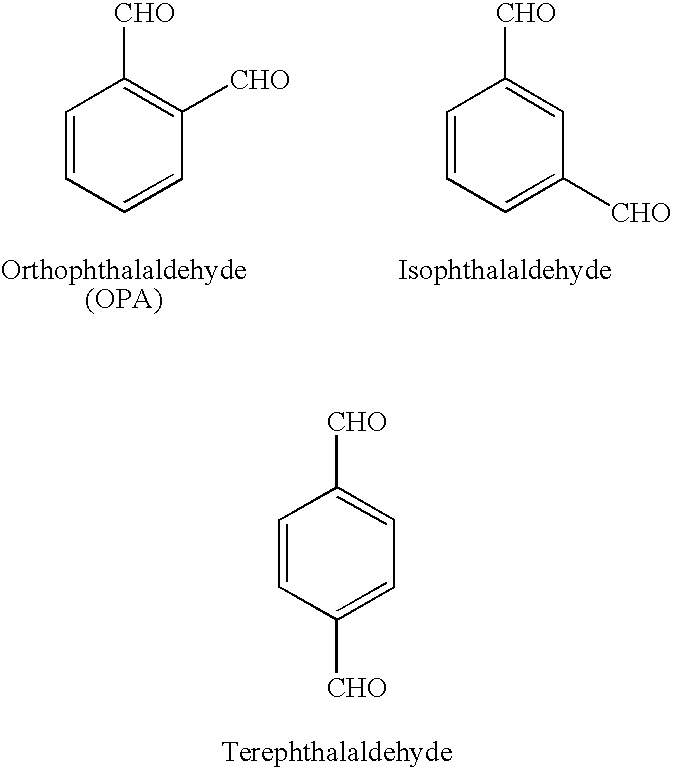Broad Spectrum Disinfecting and Sterilizing Composition
- Summary
- Abstract
- Description
- Claims
- Application Information
AI Technical Summary
Benefits of technology
Problems solved by technology
Method used
Image
Examples
example 1
Bacterial Testing
[0048]Bacteria (gram negative): Pseudomonas aeruginosa
[0049]Pathogenesis: Opportunistic pathogen in humans, cause of 1 in 10 nosocomial infections1, causes wound, blood, burn, urinary tract, lung and ear infections. 1http: / / textbookofbacteriology.net / pseudomonas.html
[0050]Concentration of Bacteria: 6.81 log10 (CFU / g)
[0051]Solution Contact Time: 1 minute
[0052]Dilution media: hard water (400 ppm)
[0053]Bio burden: 5% organic soil
[0054]The tests were performed using the ISO-GRID™ membrane filter system (Neogen Corp., Lansing, Mich., USA) according to a slightly modified procedure described in the ISO-GRID™ Methods Manual (3rd Ed.; QA Life Sciences, Inc., San Diego, Calif., USA; 1999). The test results are compiled in Table 1 below.
TABLE 1OPAiDDABCiiResultsConcentrationConcentrationLog10 ReductionSample No.(ppm)(ppm)(percent kill)2110007006.81 (100%) 210005006.81 (100%) 307005.95 (87.4%)4100002.74 (40.2%)iOrthophthalaldehydeiiDidecyldimethylammonium bicarbonate / carbonat...
example 2
Virus Testing
[0056]Virus: Canine parvovirus.
[0057]Pathogenesis: Severe debilitating and often fatal virus of dogs, especially puppies. It attacks cardiac and intestinal tissue causing heart failure and sepsis.
[0058]Concentration: See AOAC Use Dilution Test procedure3 3http: / / www.epa.gov / oppbead1 / methods / atmpmethods / MB-05-04.pdf
[0059]Dilution media: hard water (400 ppm)
[0060]Bio burden: 5% organic soil
TABLE 2Sample59% OPAi / 41% DDABCii60% DDACiii / 40%No.(ppm)ADBACiv (ppm)Result117000Pass206800FailiOrthophthalaldehydeiiDidecyldimethylammonium bicarbonate / carbonateiiiDidecyldimethylammonium chlorideivAlkyldimethylbenzylammonium chloride
[0061]As demonstrated in Table 2, quats alone are incapable of killing parvovirus, even at levels of 6800 ppm. However, the composition according to the invention, i.e., the 59% OPA / 41% DDABC mix, is sufficient to provide complete kill of the parvovirus.
example 3
[0062]Bacteria (neither gram negative nor gram positive4): Mycobacterium bovis 4http: / / www.biohealthbase.org / GSearchMycobacterium_Organismjsp?decorator=Mycobacterium
[0063]Pathogenesis: Cause of tuberculosis in cattle and occasionally in humans. M. bovis is often utilized in testing as a substitute for the human pathogen, Mycobacterium tuberculosis.
[0064]Concentration: 5.8* 105 CFU / carrier. See AOAC Tuberculocidal Activity of Disinfectant Test5,6 5http: / / www.epa.gov / oppbead1 / methods / atmpmethods / MB-02-03 .pdf6http: / / www.epa.gov / oppad001 / dis_tss_docs / dis-06.htm
[0065]Contact time: Ten minutes
[0066]Bio burden: 5% fetal bovine serum
TABLE 3ResultsPass / Fail(Intermediate(IntermediateSample No.% DDABCi% OPAii30 day read)30 day read)1.2.001 / 10Fail2.00.51 / 10Fail3.2.00.50 / 10Pass4.1.00.50 / 10Passididecyldimethylammonium bicarbonate / carbonateiiOrthophthalaldehyde
[0067]Mycobacterium bovis, often used as a test substitute for the human pathogen Mycobacterium tuberculosis, is completel...
PUM
| Property | Measurement | Unit |
|---|---|---|
| Time | aaaaa | aaaaa |
| Time | aaaaa | aaaaa |
| Time | aaaaa | aaaaa |
Abstract
Description
Claims
Application Information
 Login to View More
Login to View More - R&D
- Intellectual Property
- Life Sciences
- Materials
- Tech Scout
- Unparalleled Data Quality
- Higher Quality Content
- 60% Fewer Hallucinations
Browse by: Latest US Patents, China's latest patents, Technical Efficacy Thesaurus, Application Domain, Technology Topic, Popular Technical Reports.
© 2025 PatSnap. All rights reserved.Legal|Privacy policy|Modern Slavery Act Transparency Statement|Sitemap|About US| Contact US: help@patsnap.com

